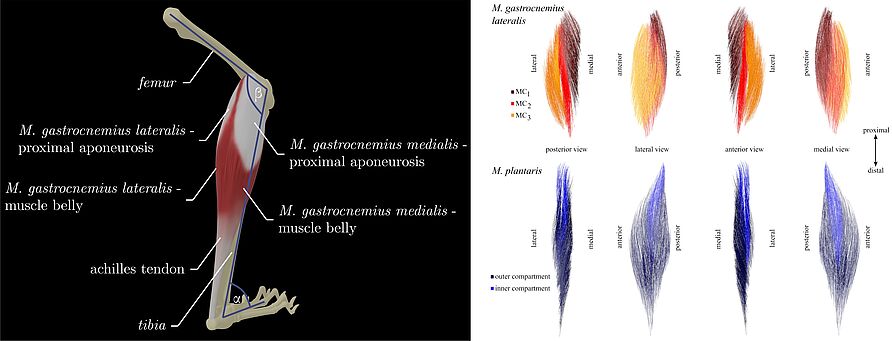The function of a muscle is highly dependent on its architecture, which is characterized by the length, pennation, and curvature of the fascicles, and the geometry of the aponeuroses. During in vivo function, muscles regularly undergo changes in length, thereby altering their architecture. During passive muscle lengthening, fascicle length (FL) generally increases and the angle of fascicle pennation (FP) and the fascicle curvature (FC) decrease, while the aponeuroses increase in length but decrease in width. Muscles are differently structured, making their change during muscle lengthening complex and multifaceted. To obtain comprehensive data on architectural changes in muscles during passive length, the present study determined the three-dimensional fascicle geometry of rabbit M. gastrocnemius medialis (GM), M. gastrocnemius lateralis (GL), and M. plantaris (PLA). For this purpose, the left and right legs of three rabbits were histologically fixed at targeted ankle joint angles of 95° (short muscle length [SML]) and 60° (long muscle length [LML]), respectively, and the fascicles were tracked by manual three-dimensional digitization. In a second set of experiments, the GM aponeurosis dimensions of ten legs from five rabbits were determined at varying muscle lengths via optical marker tracking. The GM consisted of a uni-pennated compartment, whereas the GL and PLA contained multiple compartments of differently pennated fascicles. In the LML compared to the SML, the GM, GL, and PLA had on average a 41%, 29%, and 41% increased fascicle length, and a 30%, 25%, and 33% decrease in fascicle pennation and a 32%, 11%, and 35% decrease in fascicle curvature, respectively. Architectural properties were also differentiated among the different compartments of the PLA and GL, allowing for a more detailed description of their fascicle structure and changes. It was shown that the compartments change differently with muscle length. It was also shown that for each degree of ankle joint angle reduction, the proximal GM aponeurosis length increased by 0.11%, the aponeurosis width decreased by 0.22%, and the area was decreased by 0.20%. The data provided improve our understanding of muscles and can be used to develop and validate muscle models.
M. Borsdorf, S. Papenkort, M. Böl, T. Siebert
Influence of muscle length on the three-dimensional architecture and aponeurosis dimensions of rabbit calf muscles
Journal of the Mechanical Behavior of Biomedical Materials, 152, 106452, (2024) [Link]

